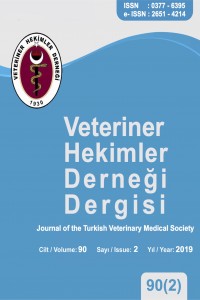3 boyutlu baskı dil kemik modellerinin karşılaştırmalı veteriner anatomi eğitiminde uygulanabilirliği ve verimliliği
Abstract
Üç boyutlu (3B) baskı olarak da bilinen eklemeli üretim; mühendislik, |
References
- 1. AbouHashem Y, Dayal M, Savanah S, Strkalj G (2015): The application of 3D printing in anatomy education. Med Educ Online, 20, 29847.
- 2. Cohen J, Reyes SA (2015): Creation of a 3D printed temporal bone model from clinical CT data. Am J Otolaryngol, 36(5), 619-624.
- 3. Estai M, Bunt S (2016): Best teaching practices in anatomy education: A critical review. Ann Anat, 208, 151-157.
- 4. HAS (2018): Health and safety authority 2018: Code of practice for the chemical agents regulations. Dublin, Ireland.
- 5. Hochman JB, Rhodes C, Wong D, Kraut J, Pisa J, Unger B (2015): Comparison of cadaveric and isomorphic three-dimensional printed models in temporal bone education. Laryngoscope, 125(10), 2353-2357.
- 6. Javaid M, Haleem A (2018): Additive manufacturing applications in orthopaedics: A review. J Clin Orthop Trauma, 9(3), 202–206.
- 7. Li F, Liu C, Song X, Huan Y, Gao S, Jiang Z (2018): Production of accurate skeletal models of domestic animals using three-dimensional scanning and printing technology. Anat Sci Educ, 11(1), 73-80.
- 8. Mowry SE, Jammal H, Myer C, Solares CA, Weinberger P (2015): A novel temporal bone simulation model using 3d printing techniques. Otol Neurotol, 36(9), 1562–1565.
- 9. Radetzki F, Mendel T, Noser H, Stoevesandt D, Röllinghoff M, Gutteck N, Delank KS, Wohlrab D (2013): Potentialities and limitations of a database constructing three-dimensional virtual bone models. Surg Radiol Anat, 35(10), 963-968.
- 10. Shepherd S, Macluskey M, Napier A, Jackson R (2017): Oral surgery simulated teaching; 3D model printing. Oral Surg, 10(2), 80-85.
- 11. Smith ML, Jones JFX (2018): Dual-extrusion 3D printing of anatomical models for education. Anat Sci Educ, 11(1), 65-72.
- 12. Thomas DB, Hisrox JD, Dixon BJ, Potgieter J (2016): 3D scanning and printing skeletal tissues for anatomy education. J Anat, 229(3), 473-481.
- 13. Vaccarezza M, Papa V (2015): 3D printing: a valuable resource in human anatomy education. Anat Sci Int, 90(1), 64–65.
The applicability and efficiency of 3 dimensional printing models of hyoid bone in comparative veterinary anatomy education
Abstract
Additive manufacturing, also known as |
References
- 1. AbouHashem Y, Dayal M, Savanah S, Strkalj G (2015): The application of 3D printing in anatomy education. Med Educ Online, 20, 29847.
- 2. Cohen J, Reyes SA (2015): Creation of a 3D printed temporal bone model from clinical CT data. Am J Otolaryngol, 36(5), 619-624.
- 3. Estai M, Bunt S (2016): Best teaching practices in anatomy education: A critical review. Ann Anat, 208, 151-157.
- 4. HAS (2018): Health and safety authority 2018: Code of practice for the chemical agents regulations. Dublin, Ireland.
- 5. Hochman JB, Rhodes C, Wong D, Kraut J, Pisa J, Unger B (2015): Comparison of cadaveric and isomorphic three-dimensional printed models in temporal bone education. Laryngoscope, 125(10), 2353-2357.
- 6. Javaid M, Haleem A (2018): Additive manufacturing applications in orthopaedics: A review. J Clin Orthop Trauma, 9(3), 202–206.
- 7. Li F, Liu C, Song X, Huan Y, Gao S, Jiang Z (2018): Production of accurate skeletal models of domestic animals using three-dimensional scanning and printing technology. Anat Sci Educ, 11(1), 73-80.
- 8. Mowry SE, Jammal H, Myer C, Solares CA, Weinberger P (2015): A novel temporal bone simulation model using 3d printing techniques. Otol Neurotol, 36(9), 1562–1565.
- 9. Radetzki F, Mendel T, Noser H, Stoevesandt D, Röllinghoff M, Gutteck N, Delank KS, Wohlrab D (2013): Potentialities and limitations of a database constructing three-dimensional virtual bone models. Surg Radiol Anat, 35(10), 963-968.
- 10. Shepherd S, Macluskey M, Napier A, Jackson R (2017): Oral surgery simulated teaching; 3D model printing. Oral Surg, 10(2), 80-85.
- 11. Smith ML, Jones JFX (2018): Dual-extrusion 3D printing of anatomical models for education. Anat Sci Educ, 11(1), 65-72.
- 12. Thomas DB, Hisrox JD, Dixon BJ, Potgieter J (2016): 3D scanning and printing skeletal tissues for anatomy education. J Anat, 229(3), 473-481.
- 13. Vaccarezza M, Papa V (2015): 3D printing: a valuable resource in human anatomy education. Anat Sci Int, 90(1), 64–65.
Details
| Primary Language | English |
|---|---|
| Subjects | Veterinary Surgery |
| Journal Section | RESEARCH ARTICLE |
| Authors | |
| Publication Date | June 15, 2019 |
| Submission Date | January 28, 2019 |
| Acceptance Date | February 24, 2019 |
| Published in Issue | Year 2019 Volume: 90 Issue: 2 |
Cited By
3d printing of skull models in horse, ox and pig
Veteriner Hekimler Derneği Dergisi
https://doi.org/10.33188/vetheder.1439194
Application of augmented reality models of canine skull in veterinary anatomical education
Anatomical Sciences Education
https://doi.org/10.1002/ase.2372
3D printing modeling of the digital skeleton of the horse
Veteriner Hekimler Derneği Dergisi
https://doi.org/10.33188/vetheder.882558
Three-dimensional bone modeling of forelimb joints in New Zealand Rabbit: A Micro-Computed Tomography study
Ankara Üniversitesi Veteriner Fakültesi Dergisi
https://doi.org/10.33988/auvfd.762615
Veteriner Hekimler Derneği Dergisi (Journal of Turkish Veterinary Medical Society) is an open access publication, and the journal’s publication model is based on Budapest Access Initiative (BOAI) declaration. All published content is licensed under a Creative Commons CC BY-NC 4.0 license, available online and free of charge. Authors retain the copyright of their published work in Veteriner Hekimler Derneği Dergisi (Journal of Turkish Veterinary Medical Society).
Veteriner Hekimler Derneği / Turkish Veterinary Medical Society


